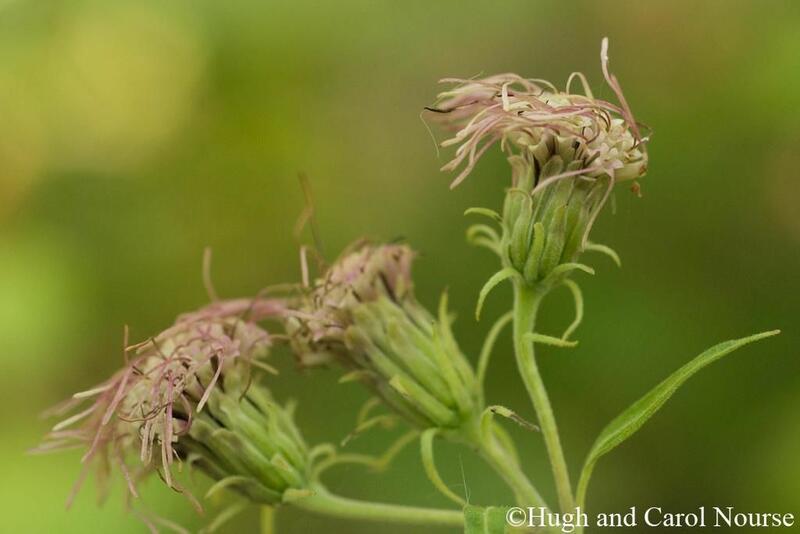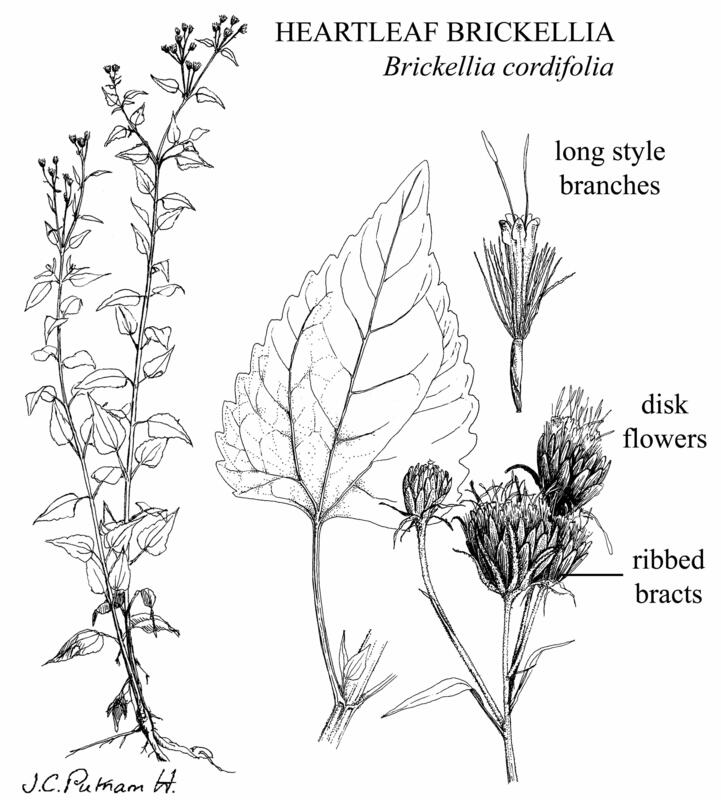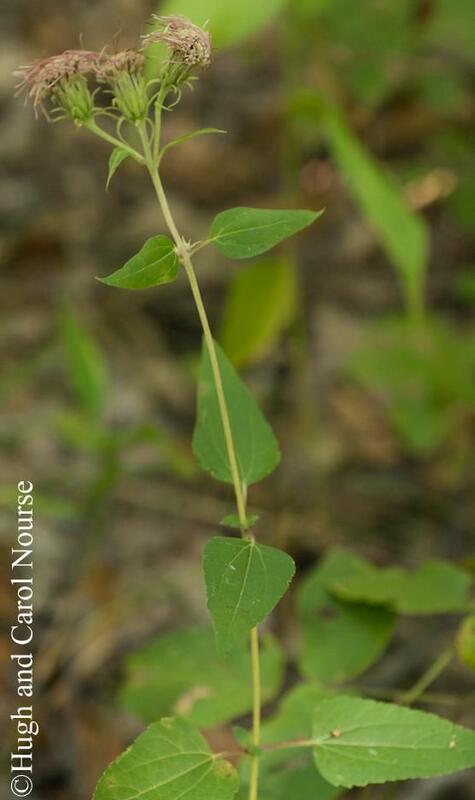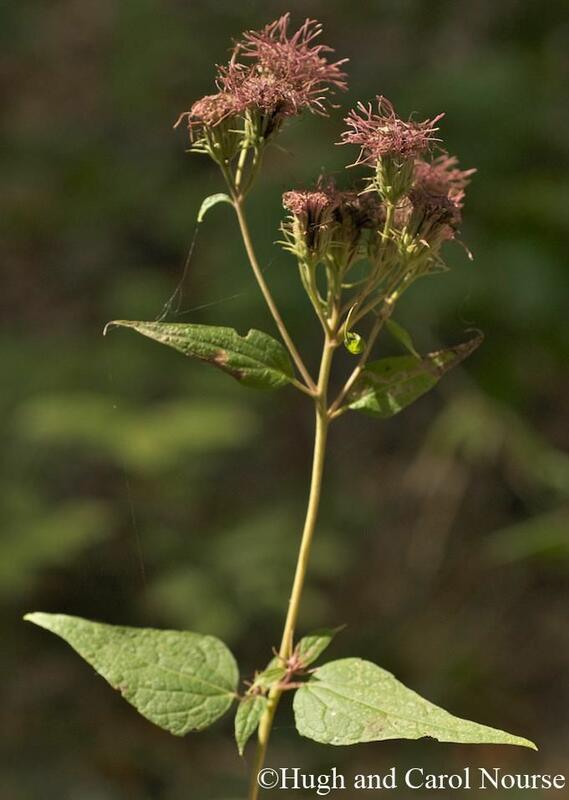







Loading profile. Please wait . . .
Brickellia cordifolia Ell.
Heartleaf Brickellia




Federal Protection: No US federal protection
State Protection: Threatened
Global Rank: G3
State Rank: S2
Element Locations Tracked in Biotics: Yes
SWAP High Priority Species (SGCN): Yes
Element Occurrences (EOs) in Georgia: 25
Habitat Summary for element in Georgia: Mesic hardwood forests
Perennial herb with slightly ribbed, softly hairy stems, 1.6 - 5 feet (50 - 150 cm) tall, often fallen over during flowering. Leaves are 2 - 4 inches (5 - 10 cm) long, with toothed margins, pointed tips, and rounded or squared-off bases; opposite at midstem, sometimes alternate near the top of the stem; lower surfaces of leaves slightly hairy and dotted with glands. Involucral bracts surrounding the base of the flower head are narrow and pointed; the outermost bracts are green and spreading, the innermost bracts pinkish, finely grooved, and not spreading. Flower heads are up to 0.8 inch (2 cm) across, with 35 - 45 dark pink disc flowers; there are no ray flowers; long, pink style branches give the heads a bristly or mop-head look. Fruits are about 0.2 inch (5 mm) long, dry, seed-like, surrounded by barbed, purplish bristles.
Eastern False-boneset (Brickellia eupatorioides) leaves are narrow with wedge-shaped bases and flower heads with white bristles.
Ageratum (Ageratina aromatica), with white flowers, and mistflower (Conoclinium coelestinum), with blue flowers, have similar leaves.
Young sprouts of American Beauty-berry (Callicarpa americana), with opposite, toothed leaves, resemble immature Heartleaf Brickellia, but Beauty-berry leaves are wedge-shaped at the base.
None in Georgia.
Moist, pine-oak-hickory woods and flats; dry woods, often with Southern Red Oak and Loblolly Pine; sandy, well drained riverbanks; upper ravine slopes with Spruce Pine, Southern Magnolia, and White Oak; often growing in basic soils. Usually in sunny openings or along edges of roads and trails; may persist in shady, overgrown woods and disturbed areas without flowering.
Little information has been published about the life history of Heartleaf Brickellia. It is a perennial herb that dies back to the ground in the winter, producing new growth in the spring and flowering in late summer and fall. Its flowers are visited by a variety of insect pollinators, including butterflies, bees, and flies. The seeds are dispersed by wind, gravity, and animals; pappus bristles surrounding the seeds probably aid in seed dispersal by both wind and animals.
Surveys are best conducted during flowering (late August–October).
Georgia, southeast Alabama, and north Florida.
Conversion of habitat to pine plantations, pasture, and developments. Fire suppression in upland woods, logging and other mechanical clearing in ravines and on slopes.
Brickellia cordifolia is ranked S2 by the Georgia Department of Natural Resources, indicating that it is imperiled in the state. It is also listed as Threatened by the State of Georgia. About 25 populations have been documented in the last 20 years; 17 of these occur on Department of Defense land, one in a state park, the others on private land.
Apply prescribed fire every 3 - 5 years during the growing season in pine-oak woods, allowing fire to burn into upper slopes of ravines. Avoid clearcutting and conversion of upland woods to pine plantations or other development.
Chafin, L.G. 2007. Field guide to the rare plants of Georgia. State Botanical Garden of Georgia and University of Georgia Press, Athens.
Chafin, L.G. 2000. Field guide to the rare plants of Florida. Florida Natural Areas Inventory, Tallahassee.
Cronquist, A. 1980. Vascular flora of the southeastern United States, Vol. 1, Asteraceae. University of North Carolina Press, Chapel Hill.
GADNR. 2019. Element occurrence records for Brickellia cordifolia. Georgia Department of Natural Resources, Wildlife Resources Division, Social Circle, Georgia.
Kral, R. 1983. A report on some rare, threatened, or endangered forest-related vascular plants of the South. Technical Publication R8-TP2. United States Forest Service, Atlanta.
NatureServe. 2019. Brickellia cordifolia comprehensive report. NatureServe Explorer. Arlington, Virginia. http://explorer.natureserve.org/servlet/NatureServe?searchName=Brickellia%20cordifolia
Scott, R.W. 2006. Brickellia cordifolia species account. Flora of North America, vol. 22. Oxford University Press, New York. http://www.efloras.org/florataxon.aspx?flora_id=1&taxon_id=220001923
Weakley, A.S. 2015. Flora of the southern and mid-Atlantic States. University of North Carolina Herbarium, University of North Carolina, Chapel Hill. http://www.herbarium.unc.edu/flora.htm
Linda G. Chafin
L. Chafin, Feb. 2008: original account.
K. Owers, Jan. 2010: updated status and ranks, added pictures.
L. Chafin, Jan 2020: updated original account.




